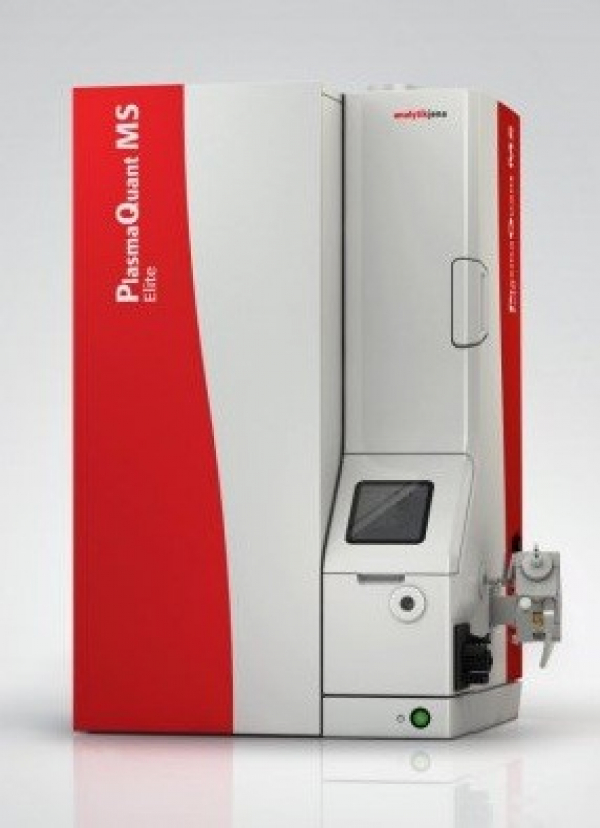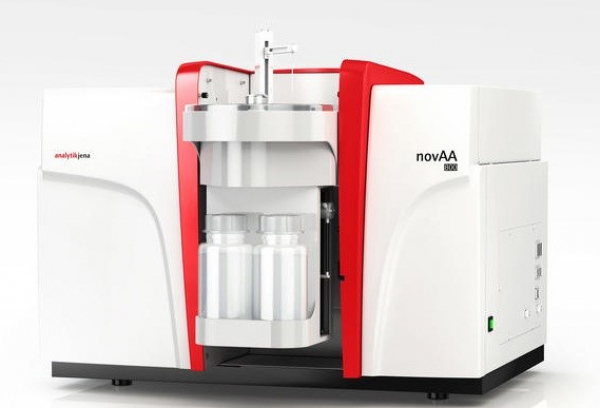INDUCTIVELY COUPLED PLASMA - MASS SPECTROMETRY (ICP-MS)
Working Principle:
ICP-MS consists of two units: Inductively Coupled Plasma (ICP) and Mass Spectrometry (MS). Basically; After the elements in the sample are ionized in the ICP, they are sent to mass spectroscopy (MS), where they are separated and measured according to their mass/charge (m/z) ratios. Ionization is achieved by sending samples to a high-temperature plasma. Although argon is generally used for plasma, helium and hydrogen are also preferred for some elements. Samples are sent to the nebulizer and spray chamber in liquid form. High-speed argon flow causes fog of the sample. Very small droplets are transported to the argon plasma and the remainder is sent directly to the waste. The sample, which is vaporized and ionized by argon plasma at a temperature of 10000 K, is transferred to a high vacuum environment with the help of sampler cone and skimmer cone. Ions focused on the quadrupole are separated according to the mass/charge (m/z) ratio in the mass spectrometer and sent to the detector for measurement.

Marka/ Model: AnalytikJena/ Plasmaquant MS Elite
Device Features:
ICP-MS Device is suitable for direct, fast and reliable trace element determinations. It enables quantitative analysis of many elements at different concentrations simultaneously.
Elements: Zn, Mg, Ca, Na, Al, K, Cu, Fe, Co, P, As, Pb, Sn, Cr, Hg, Mn, Se, Ni, Cd, B, Sb, Ba, Be, Mo, Si, Ag, Tl, Li, Bi, In, Ge, Sc, Tb, Y
Sample Delivery Terms:
Detailed information about the examples should be given; sample composition, expected concentrations, solvents used, etc. If the sample has been placed in solution, a blank solution should be brought with the sample.
Application Areas:
- Water and environmental analysis
- Geochemical analyzes
- food analysis
- Metallurgical analysis
- petrochemical
Device Specialists:
1. Specialist Ülkü Demirci
E-mail: ulku.demirci@iste.edu.tr
Phone: 0 (326) 613 56 00
Internal: 3152
2. Specialist Damla Anıl Çelebi
E-mail: damla.anil@iste.edu.tr
Phone: 0 (326) 613 56 00
Internal: 3152
ATOMIC ABSORBTION SPECTROMETER (AAS)
Working Principle:
AAS is a device used for the quantitative analysis of trace elements (ppm and ppb levels). It is a single element technique that measures the concentration of a sample by comparing the absorbance of the sample with the absorbance of standards (calibration solutions of known concentrations). Since the wavelength of the element sought is obtained by excitation of the element itself in the cathode lamp used, it can give accurate results for the amounts in the sample. Depending on the type and amount of the element to be determined, analyzes are made by choosing the appropriate Flame, Graphite Furnace and Hydride techniques.

Brand/Model: AnalytikJena/ novAA 800
Device Features:
System: Flame System, Graphite Furnace, Hydride System
Lamps: Ni, Hg, Pb, Ca, Sn, Cd, Se, As
Background correction: Deuterium hollow cathode lamp (D2-HCL)
Sample Delivery Terms:
Detailed information about the examples should be given; Sample composition, expected concentrations, specifications should be stated. If the sample has been placed in solution, a blank solution should be brought with the sample.
Application Areas:
- Water and environmental analysis
- By geochemical analysis
- food analysis
- Metallurgical analysis
Device Specialists:
1. Specialist Ülkü Demirci
E-mail: ulku.demirci@iste.edu.tr
Phone: 0 (326) 613 56 00
Internal: 3152
2. Specialist Damla Anıl Çelebi
E-mail: damla.anil@iste.edu.tr
Phone: 0 (326) 613 56 00
Internal: 3152
UV- GÖRÜNÜR BÖLGE (UV-Vis) SPEKTROFOTOMETRESİ
Working Principle:
The basis of ultraviolet and visible light (UV-Vis) absorption spectroscopy is based on the decrease in light intensity of a beam of light after passing through a sample/reflecting from a sample surface. This decrease indicates that the amount of absorbed substance increases. Many molecules absorb UV or visible wavelengths. This device finds the concentration of the sample by measuring the amount of substance absorbed at a certain wavelength in terms of absorbance. UV-Vis spectroscopy is generally used to measure molecules or inorganic ions/complexes in solution.
Brand/Model: Jasco/ V-730
Device Features:
Wavelength range: 190-1100 nm
Double beam, single monochromator spectrophotometer
Light source: Dotterium lamp: 190-350 nm
Halogen lamp: 330-1100 nm
Analyzes made:
- Spectrum scan
- Transmittance measurement
- Quantitative analysis
Sample Delivery Terms:
Detailed information about the examples should be given; Sample composition, expected concentrations, specifications should be stated. If the sample has been placed in solution, a blank solution should be brought with the sample.
Application Areas:
- Water and environmental analysis
- Geochemical analyzes
- By biochemical analysis
- food analysis
Device Specialists:
1. Specialist Damla Anıl Çelebi
E-mail: damla.anil@iste.edu.tr
Phone: 0 (326) 613 56 00
Internal: 3152
2. Specialist Dr. Hasan Köseoğlu
E-mail: hasan.koseoglu@iste.edu.tr
Phone: 0 (326) 613 56 00
Internal: 3153
FOURIER TRANSFORM-INRED SPECTROMETTER (FT-IR)
Working Principle:
Infrared (IR) Spectroscopy is basically based on the absorption of infrared light by the sample. The basis is to evaluate the spectrum obtained by giving an absorption as a result of bending, bending, stretching, vibration or rotational movements of the bonds of molecules or atoms exposed to IR rays. Infrared light is absorbed only by molecules with variable dipole moments. (For example, while diatomic molecules such as N2, O2, Cl2 do not give results in FTIR, the FTIR spectrum of HCl can be taken).
Functional groups in the structures of solid, liquid and solution organic compounds, whether two compounds are the same, the state of the bonds in the structure, binding sites and whether the structure is aromatic or aliphatic can be determined. Qualitative and quantitative analysis of many organic and inorganic samples can be performed. While FT-IR is used especially for polymer testing, pharmaceutical and forensic analysis, it is also defined as an important technique in the materials sciences, chemistry and ceramics industries.
Brand/Model: Jasco/FT/IR-6700
Device Features:
|
Interferometer
|
28 degree Michelson interferometer, DSP (digital Signal Processor) controlled, Retro-reflector (corner-cube) mirrors with automatic alignment to optimize energy flow,
|
|
Optical System
|
Single Beam
|
|
Wavelength Range
|
MID-IR (4000-400 cm-1) TGS detector
FAR-IR (700-50 cm-1) PE-TGS detector
|
|
Wavelength Accuracy
|
± 0.01 cm-1
|
|
Scanning speed
|
20 Hz
|
|
Maximum resolution
|
0,4 cm-1
|
|
Signal-to-Noise Ratio:
(4 cm-1, 1 min, near 2,200 cm-1)
|
S/N Oranı: 47.000:1
|
|
Detector
|
DLATGS
|
|
Source of light
|
High density ceramic weld |
|
Beam Splitter
|
Ge/KBr
|
Sample Delivery Terms:
Samples must be solid or liquid. Detailed information about the examples should be given; Sample composition, solvents used, expected concentrations, and specifications should be stated. If the sample has been placed in solution, a blank solution should be brought with the sample.
Application Areas:
- Spectrum measurement
- Quantitative analysis (quantification)
- Functional Group analysis
- Percentage similarity analysis (with library)
NOTE: For quantitative analysis, the standard of the desired substance must be provided.
Device Specialists:
1. Specialist Ülkü Demirci
E-mail: ulku.demirci@iste.edu.tr
Phone: 0 (326) 613 56 00
Internal: 3152
2. Specialist Damla Anıl Çelebi
E-mail: damla.anil@iste.edu.tr
Phone: 0 (326) 613 56 00
Internal: 3152